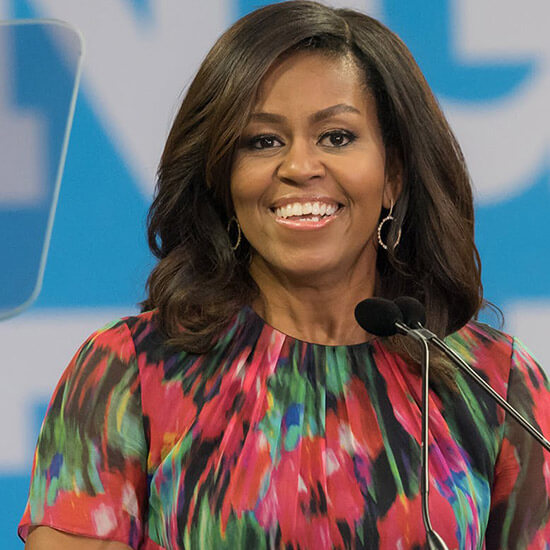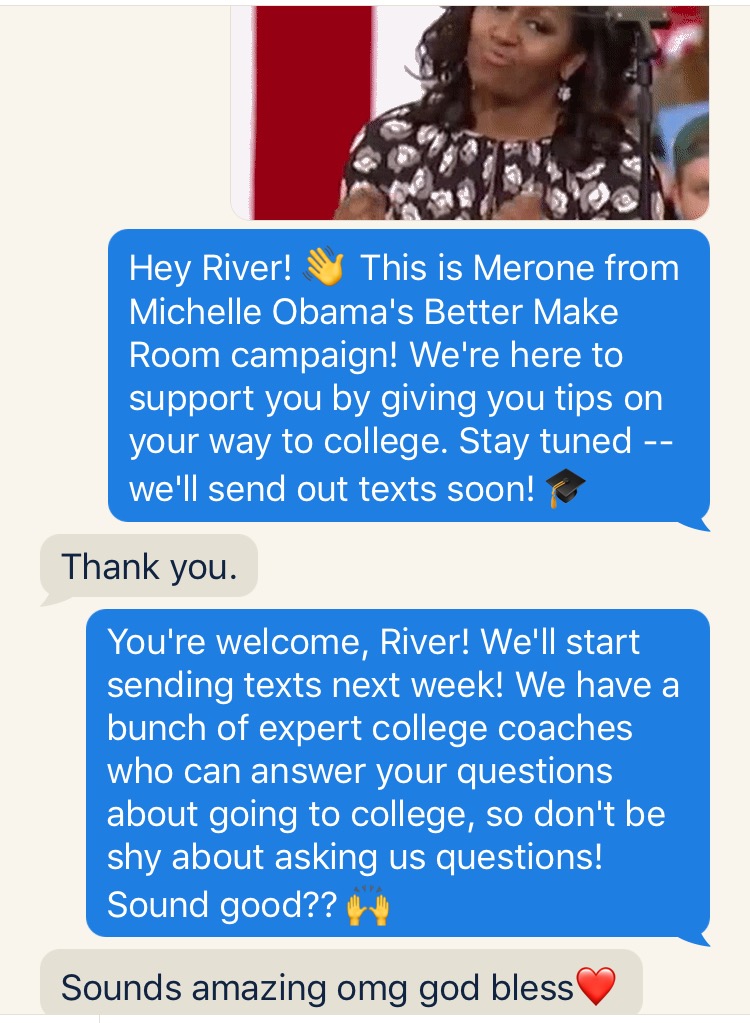Michelle Obama´s Better Make Room Campaign Aims to Help Students Text Their Way to College

In 2014 Michelle Obama launched the Reach Higher initiative, which set out to help schools and counselors help young people see college as an option. But after about a year into the program, the former first lady realized Reach Higher wasn’t directly reaching an important group: students themselves.
“Mrs. Obama said the White House press release won’t reach kids; those reach schools and state educational organizations,” says Don Yu, a former advisor to the Secretary of Education under the Obama Administration. “We needed a strategy that could reach kids and look fun.”
That sparked the creation of the Better Make Room campaign, a branch of Reach Higher that seeks to engage students in the college application process by connecting with them on social media outlets like Instagram, Twitter and Snapchat. And now, the campaign is trying out another method of outreach: text messaging.
Up Next, as the texting tool is called, allows students to text a number to ask basic college questions around applications, federal student aid or loan repayment. The free Q&A platform is intended to help both current high school students get into college, and encourage current college students to graduate—with motivational nudges from Michelle Obama herself (in the form of quotes or videos, that is, plus the occasional GIF).
Yu, who now serves as director for Better Make Room, boils down the campaign’s strategy to a single phrase: “The Michelle Obama Effect.” He’s referring to a research-backed trend on how school visits by the former First Lady can change student behavior. For instance, a study done at the University of Virginia shows that schools saw “substantial increases in the share of students completing the FAFSA” when Mrs. Obama made a visit and encouraged they complete the federal financial aid form.
But because Mrs. Obama can’t visit every school, the director says the goal is to virtually “scale up” the effect to reach hundreds of thousands of kids. “Meeting young students on their cell phones… is our theory of change, to scale up her message as possible.”

The platform launched earlier this month via a partnership with Hustle, a one-to-one text messaging startup that has been used on fundraising campaigns for both colleges and presidential candidates, including Bernie Sanders and Hillary Clinton during the 2016 election cycle.
Hustle CEO Roddy Lindsay explains that the partnership entails access to his company’s technology, which includes an analytics dashboard so Better Make Room can see how their coaches are doing and how well students are engaging, as well as technical support to onboard Better Make Room coaches who send the text responses.
The partnership with Hustle is not the first time Better Make Room has offered text-based communication with students. Last year, Up Next offered a similar service that the campaign claims reached more than 96,000 students and involved more than 1.2 million messages sent. Even more impressive, Yu claims the pilot year saw a 50 percent response rate from the students who received the messages.
What’s different this year, though, is that there will be another person on the other end rather than a more automated response. On why he was curious to try out a new platform for the texting service, Yu says “I was attracted by the manual messaging feature.”
Lindsays believes it’s what sets his company apart from other chatbot or texting campaigns. “One of the big benefits using Hustle is that it’s peer-to-peer. There is a component for following up with students on important deadlines—and having a person answer those in real time.”
Along with wanting to try out the manual texting platform, Yu shares that the strategy to reach younger students on their cell phones has a financial hook, too. With the current federal government seeking to eliminate $9 billion from education funding, the organization was looking for creative—and cost effective—ways of encouraging students to engage with the college application process. “Social media is free,” Yu underlines. (He adds that the grant-funded campaign does have expenditures, of course. Better Make Room spends on average between 15 to 18 cents per student, thanks to a custom pricing offering from Hustle.)
However, budget cuts weren’t Yu’s only concern with the latest iteration of Up Next, which is one of several college-readiness programs that Reach Higher and Better Make Room host.
Better Make Room saw major success in 2016 with its first big social push. For example, over one 24-hour period the campaign saw 440 million impressions on the hashtags #CollegeSigningDay and #BetterMakeRoom. Under a new administration, Yu wasn’t sure if those numbers would hold up.
“That success was helped out a lot by the White House. They would share [the campaign] on Twitter and Instagram,” says Yu. In 2017, and without the White House’s support on the campaign, he says he would have been happy if they had even matched those numbers from the year prior. “We only had Mrs. Obama’s social media accounts and our celebrity partners [sharing the campaign].”
To his surprise, the campaign blew up even more this year, hitting 1.15 billion impressions over a 24-hour period in May 2017.
©2024 Reach Higher COOKIE NOTICE | PRIVACY POLICY | TERMS CONDITIONS
Reach Higher is housed within The Common App, a 501(c)(3) nonprofit membership organization.

Reach Higher at Common App
info@ReachHigher.org
©2018 Reach Higher
PRIVACY POLICY | TERMS & CONDITIONS
Reach Higher and Better Make Room is housed within Common App, a nonprofit 501(c)(3) organization.









